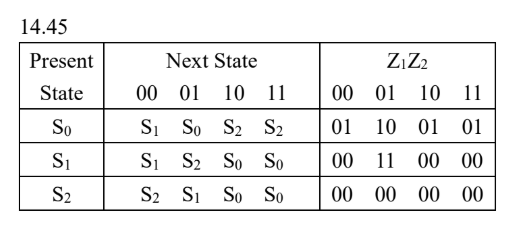Logic Design¶
see https://dlcc.notion.site/fd1e2a787b11464896f55d9684337246
Ch11 Latches and Flip-flops¶
flip-flop: only response to a ==clock input== (but not a data input)
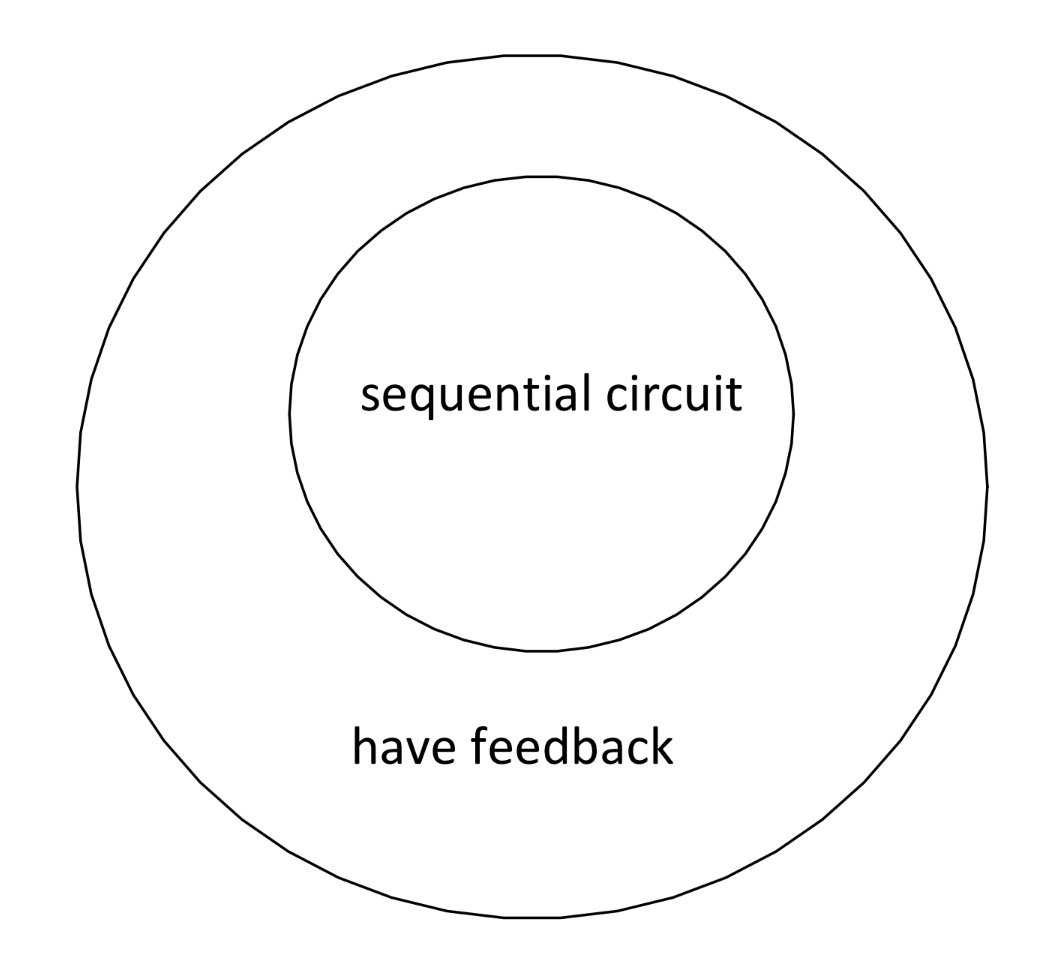

bc propagation odd number of inverters → oscillate
11.2 S-R Latch¶
original NOR S-R Latch¶
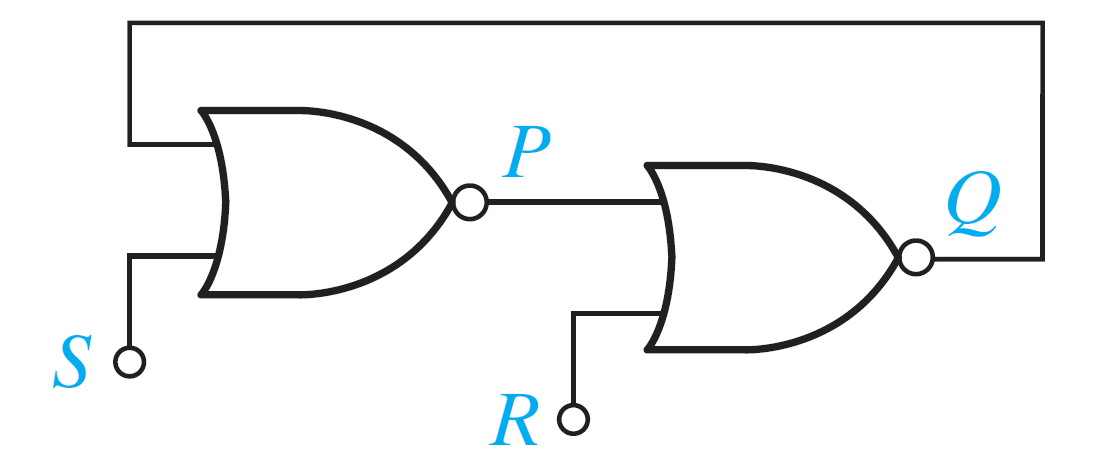 左上 → switch S → 右上 → switch S → 左下 → switch R → 右下
左上 → switch S → 右上 → switch S → 左下 → switch R → 右下
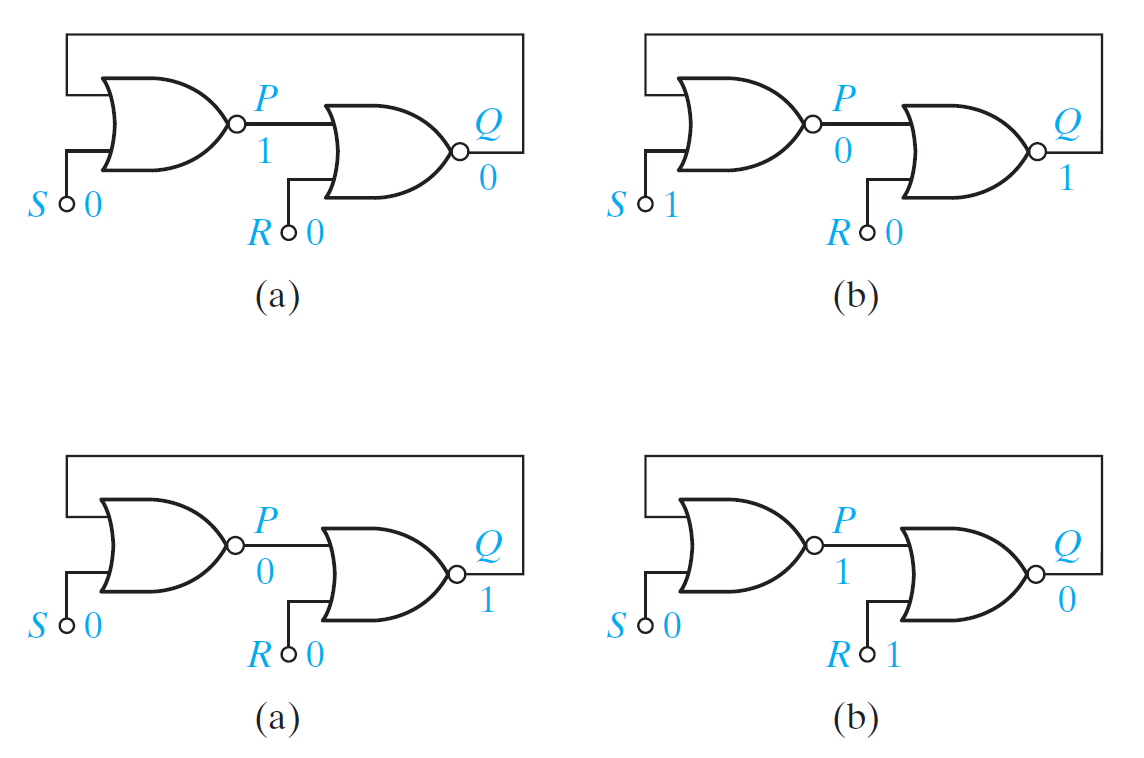
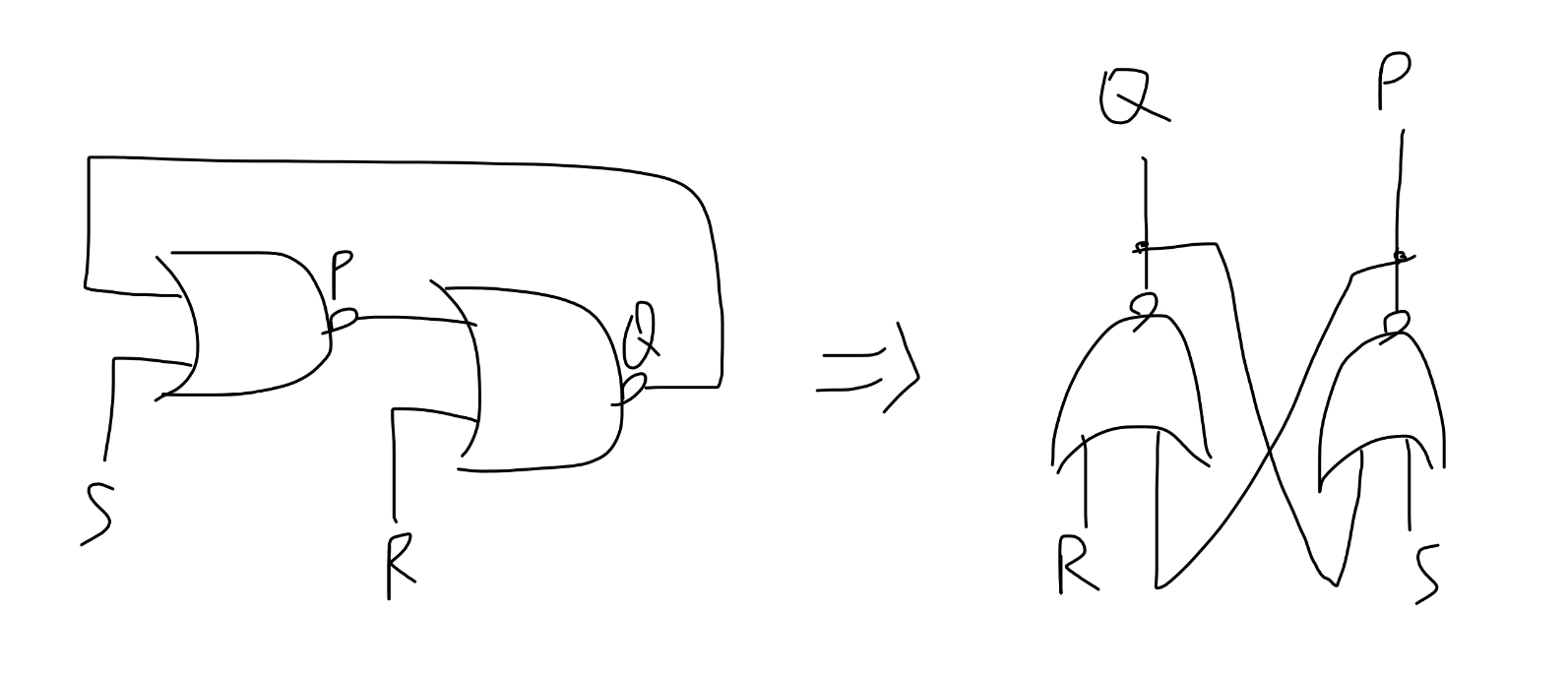
if !(S=R=1) then P == Q'
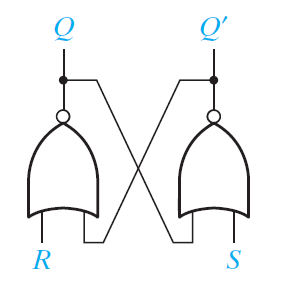
if S=R=1
when S,R=1→0
P,Q oscillate 0→1→0→1→....
time diagram¶
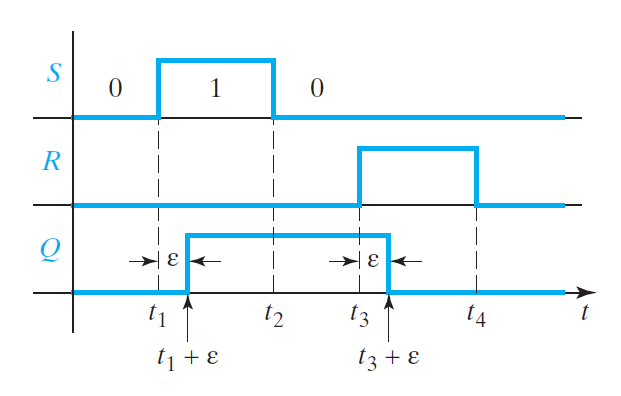
if S's or R's duration of S < ε
then Q won't change

Q+ = ((Q+S)'+R)' = (Q+S)R' = R'S + R'Q P = (S+Q)' = S'Q' bc S=R=1 is disallowed (i.e. SR=0) so
==Q+= S + R'Q==¶
(Q+=R'S + R'Q + RS)

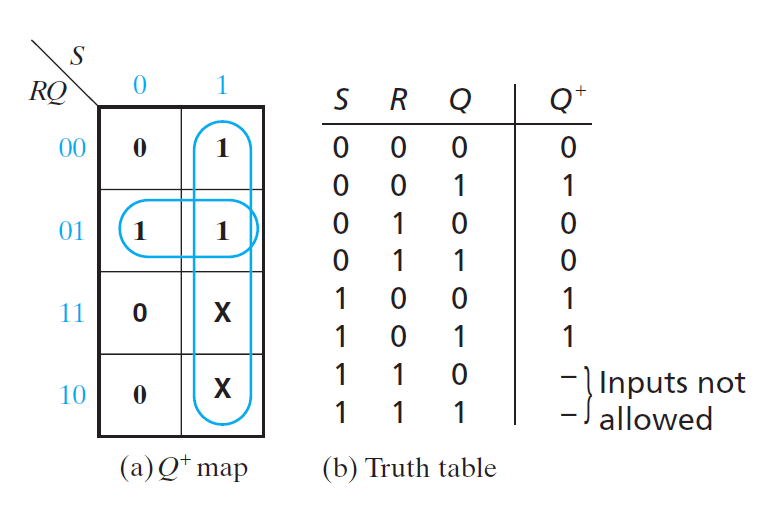
Q+=1 when
debounce switch¶
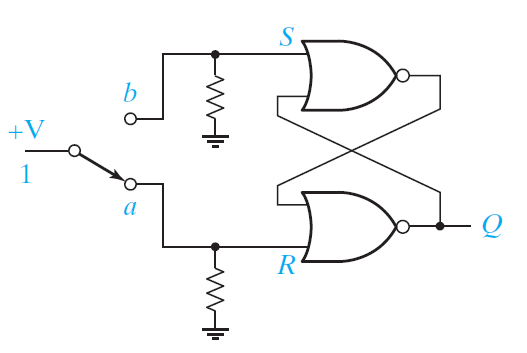
S bounces when switch to b
R bounces when switch to a
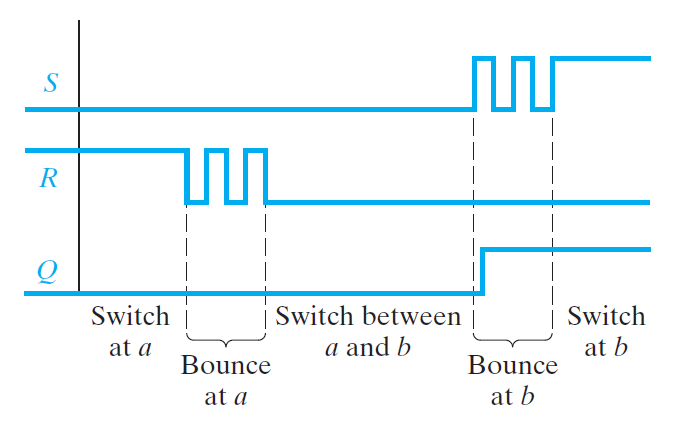
Q+=S+R'Q
Bounce at a: S=Q=0 so always 0
Bounce at b: S duration > ε let Q→1, then stays at 1 bc R=0
NAND S-R Latch¶
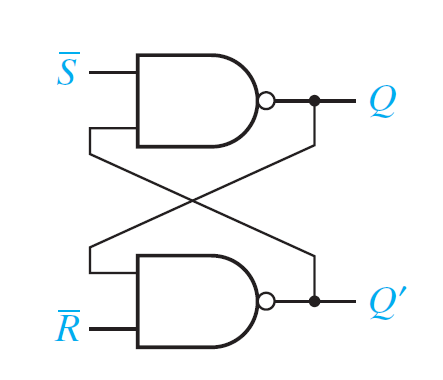
Q+ = ((QR)'S)' = QR + S'
→ = NOR S'-R' Latch
note that ==S, R switch place==
11.3 Gated Latches¶
NAND-gate gated S-R Latch¶
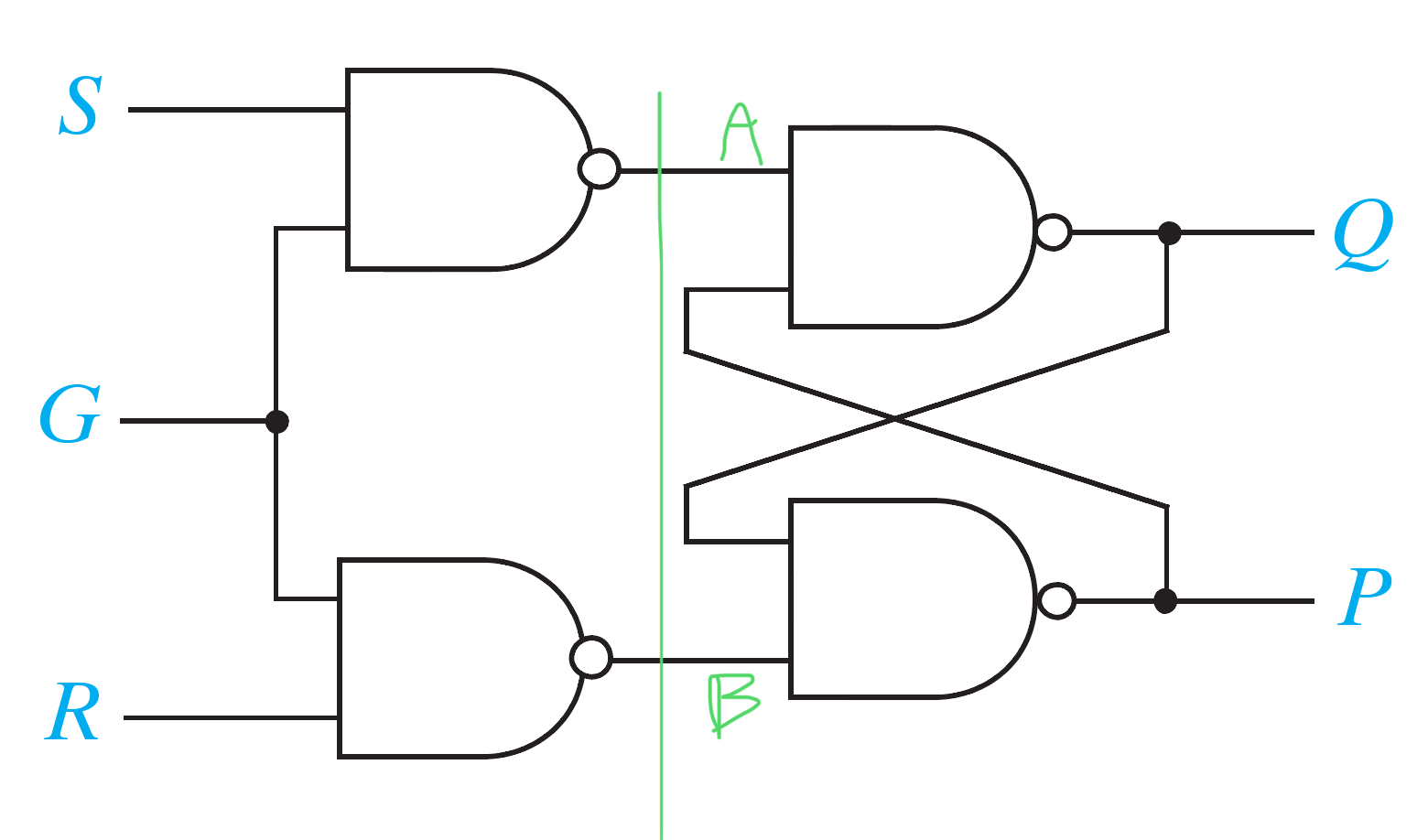
Q+ = A' + BQ = SG + (RG)'Q = SG + Q(R' + G')
P = (BQ)' = Q' + RG
when G=0, Q+=Q, P=Q' → stable
when G=1, Q+=S+QR', P=RG → original NOR S-R Latch
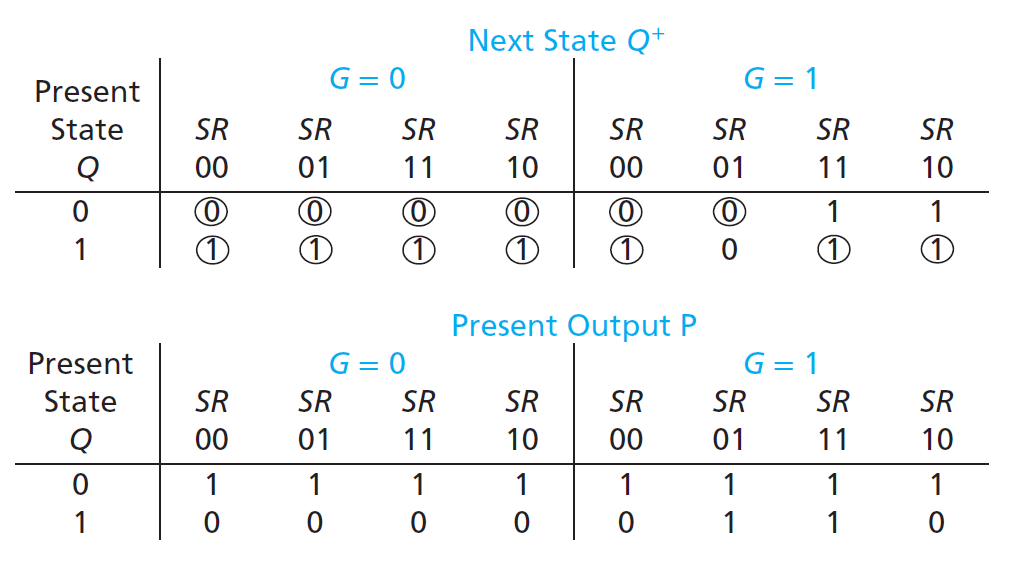
when S=R=1 and G=1→0
propogation time race
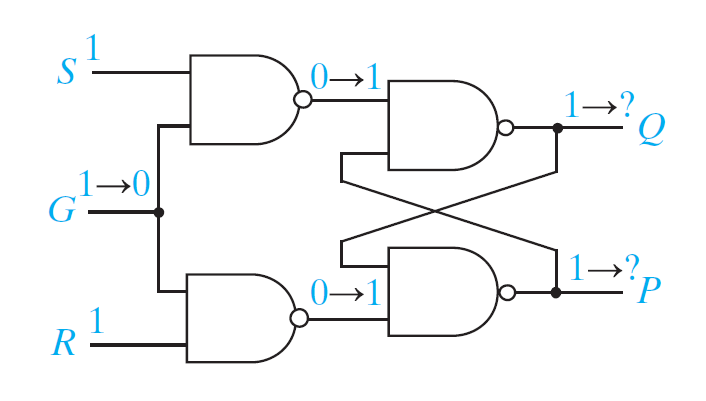
Q+=SG+Q(R'+G'):
static-1 hazard between G=0,1
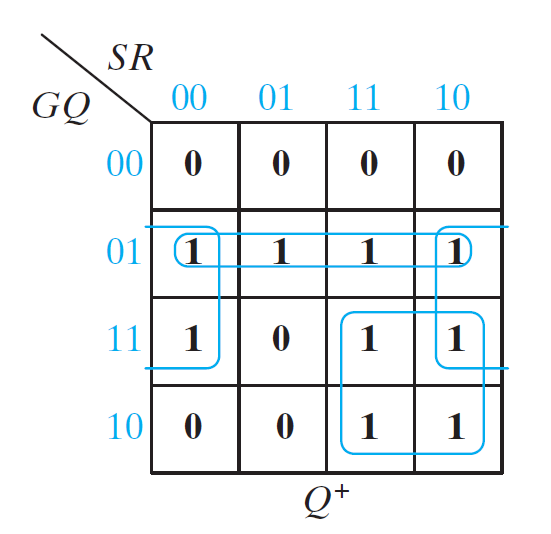
1's, 0's catching problem¶
S=R=0, G=1, Q=0
S has a 1 glitch → Q=0→1
→ 1's catching problem
NOR S-R Latch has a 0's catching problem
so S, R inputs must not have glitch
Gated D Latch¶
S = D, R = D'
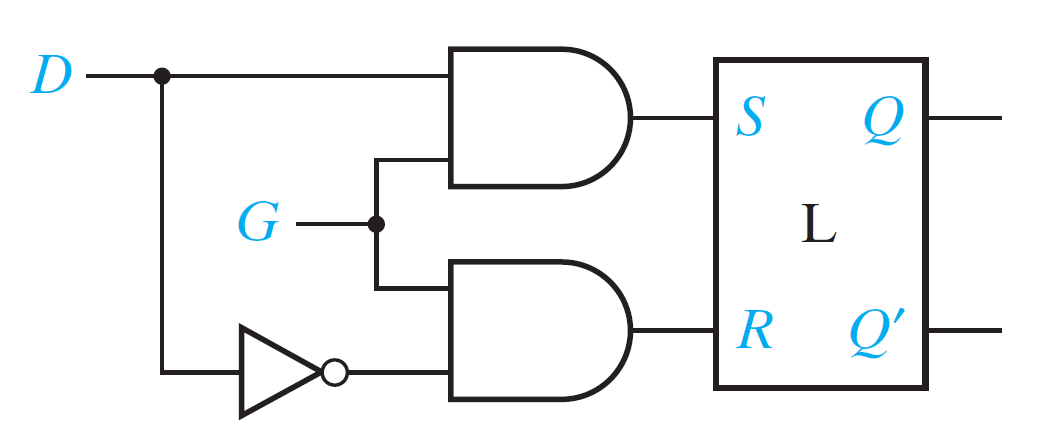
(L 是 NOR S-R latch)

when G=0, Q+ = Q
when G=1, Q+ = S+QR = D
→transparent latch
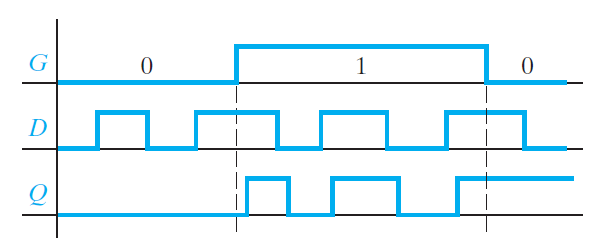
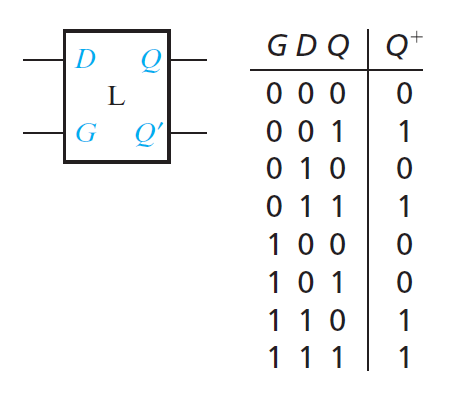 Q+ = G'Q + GD
Q+ = G'Q + GD
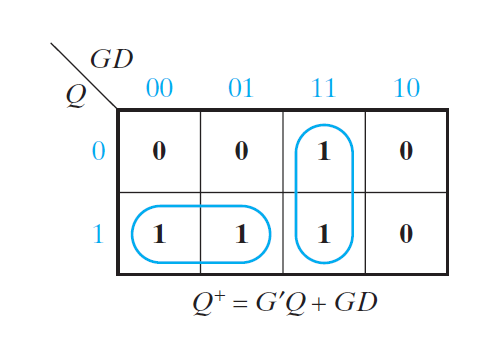
when Clk=1 and x=1, D oscillates
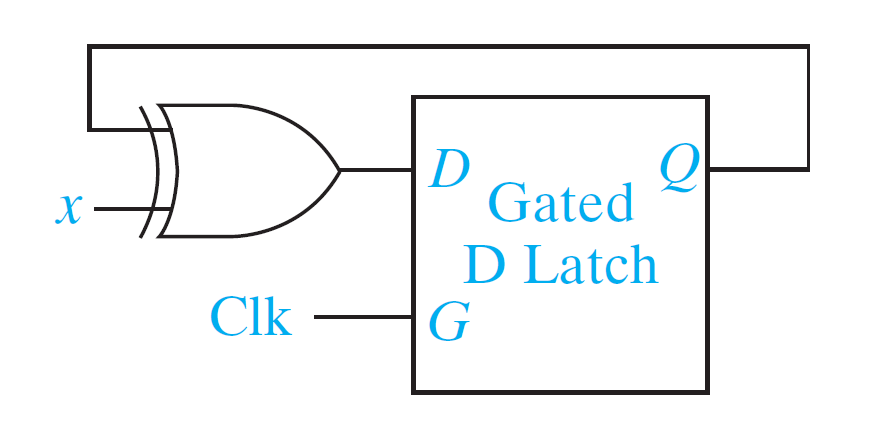
opening a clock for only a little time (let D pass to Q but not Q→Q' pass to D) will solve the problem
so we restrict the flip-flop to only change on the edge of the clock (input change → no effect)
→ edge-triggered flip-flop
11.4 Edge-Triggered D Flip-Flop¶
rising-edge trigger(left): output change when Clk=0→1
falling-edge trigger(right, has bubble): output change when Clk=1→0
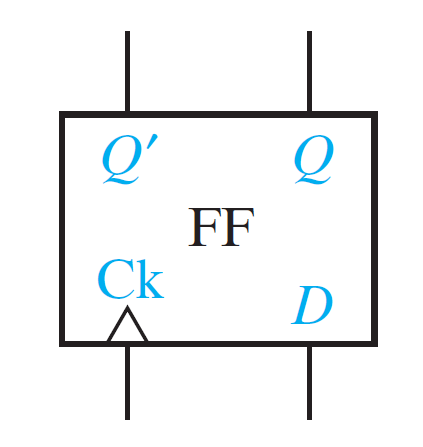
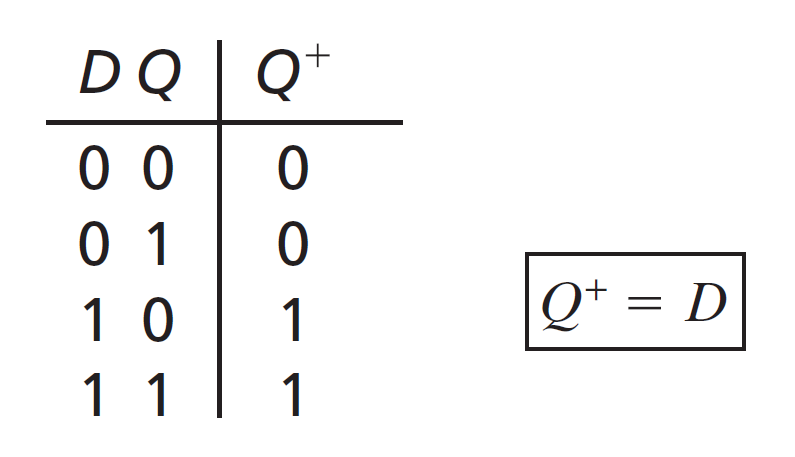
falling-edge triggered D flip-flop time diagram

when Clk=1→0, Q = D the moment Clk change→
rising edge triggered D flip-flop¶

when Clk=0, D pass to P, Q+=Q
when Clk=0→1, D pass to P pass to Q
when Clk=1, Q hold the D when Clk 0→1, D now doesn't affect anything
when Clk=0→1, nothing happens
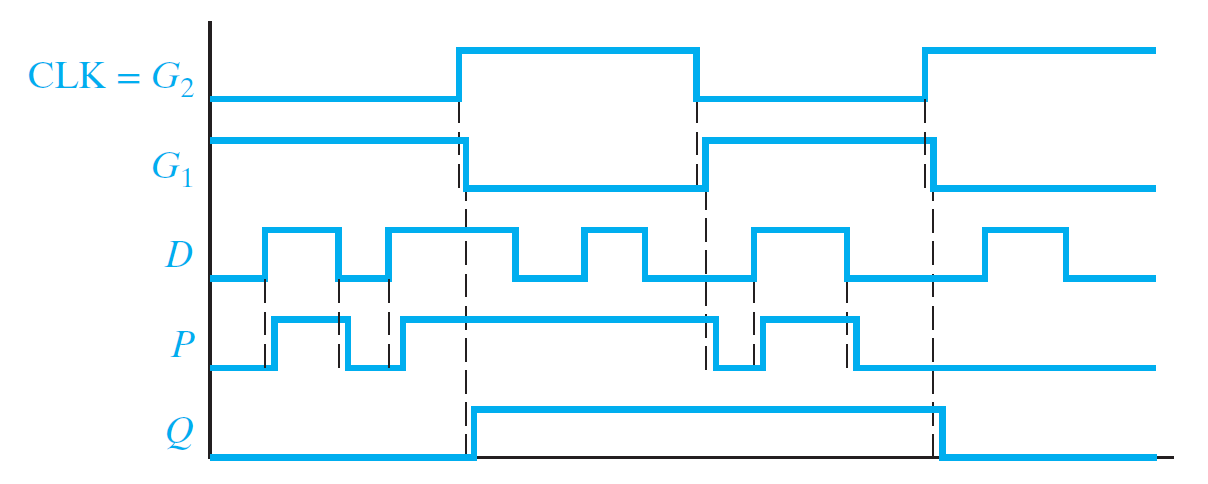
tsu (setup time) = D's must-stable time before Clk 0→1
th (hold time) = D's must=stable time after Clk 0→1
tp = clock's propagational delay

an example of minumum clock period
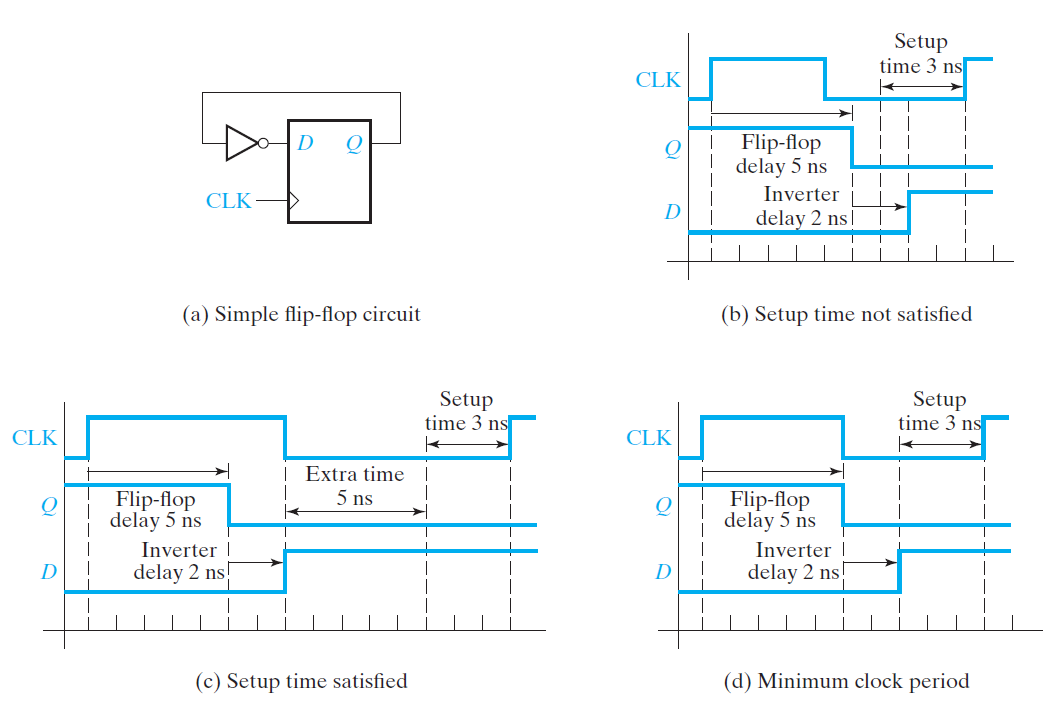
11.5 S-R Flip-Flop¶
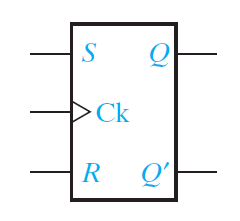
(rising-edge)

NOR-gate S-R latch: Q+=S+R'Q
when Clk=0, S1=S, R1=R (Master)
when Clk=1, Q=P

Q change when Clk=0→1
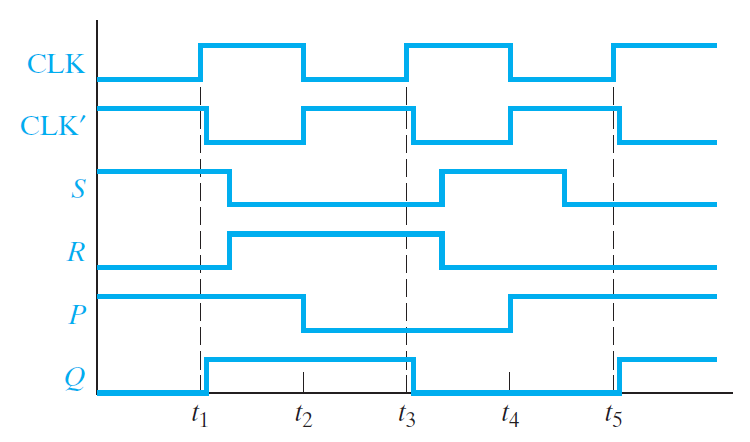
at t4, Clk=1→0, so P=S+R'Q=1
at t4, Clk=0→1, so P=1 pass to Q
but S=R=0 then, Q shoudln't change
so we ==only allow inputs change when clock is high==
11.6 J-K Flip-Flop¶
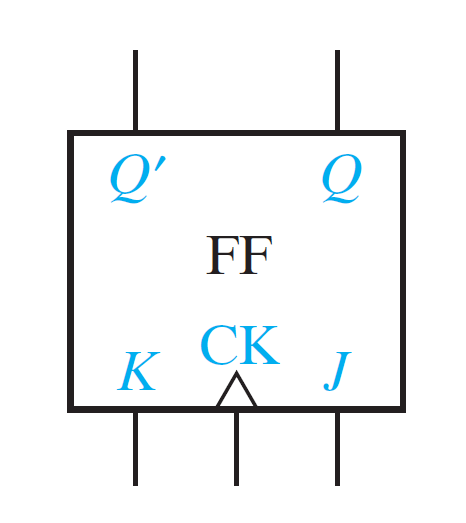
(rising-edge)

when Clk=1, ==P=JQ'+K'Q==
when J=K=1 and Clk=0→1, Q+=Q'
so ==J=K=1 is illegal==
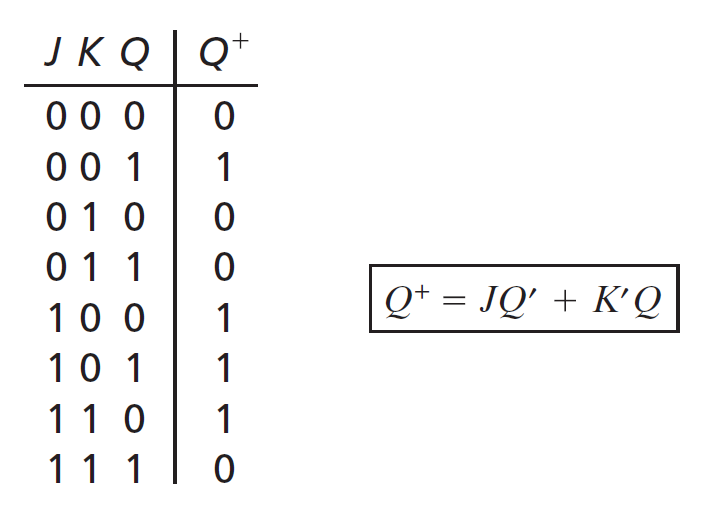
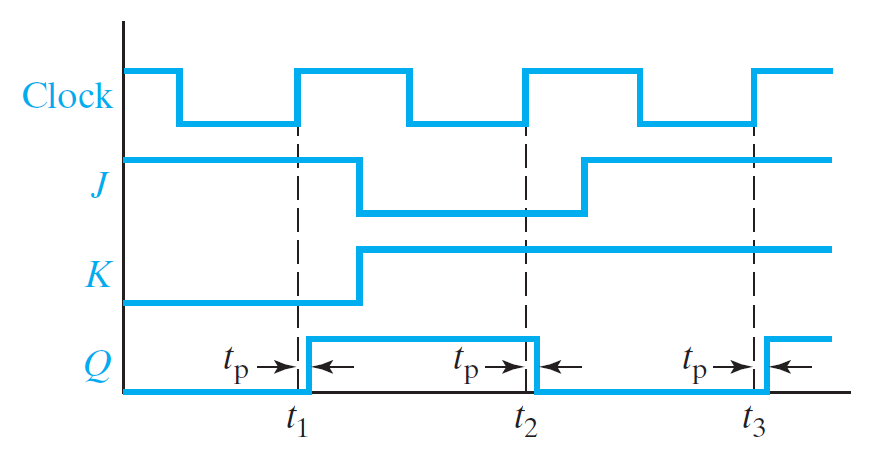
11.7 T Flip-Flop¶
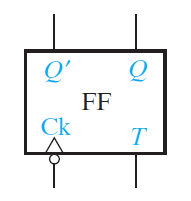
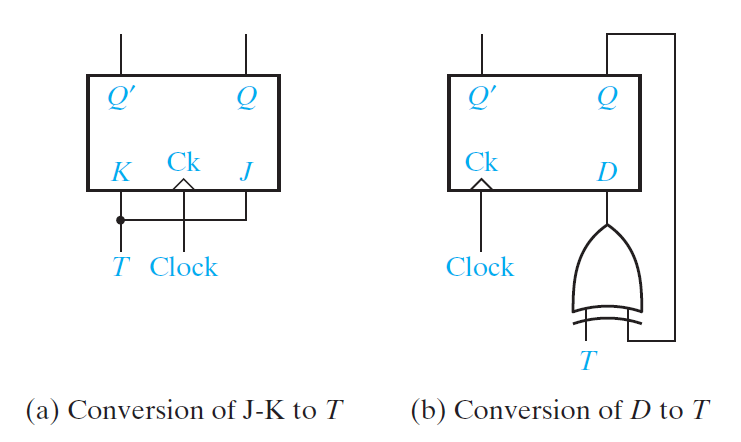
J-K flip-flop: Q+=JQ'+K'Q D flip-flop: Q+=D when Clk=1
==Q+ = TQ' + T'Q = T ⊕ Q==
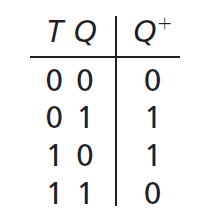
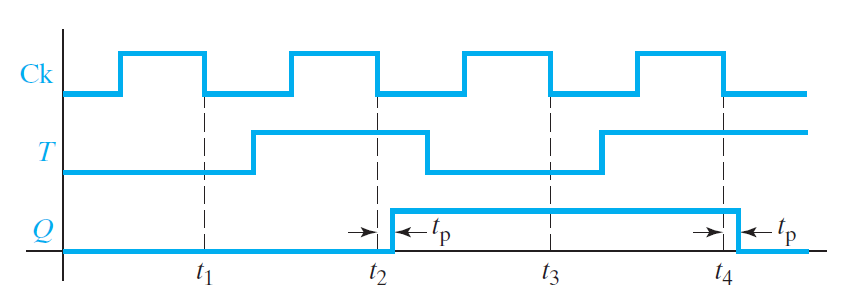
11.8 Flip-Flops with Additional Inputs¶
D flip-flop with clear and reset¶
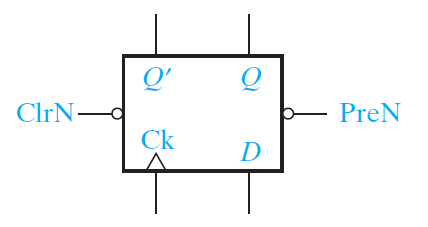 if ClrN=0 then Q→0
if ClrN=0 then Q→0
if PreN=0 then Q→1
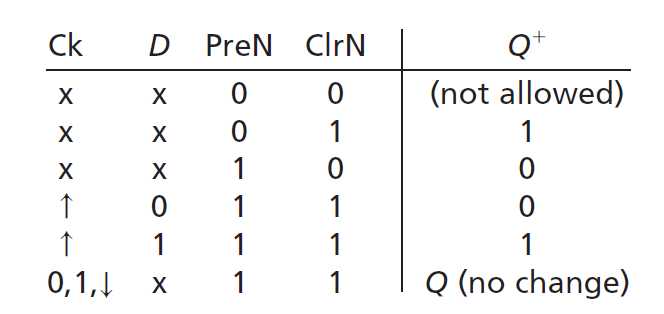
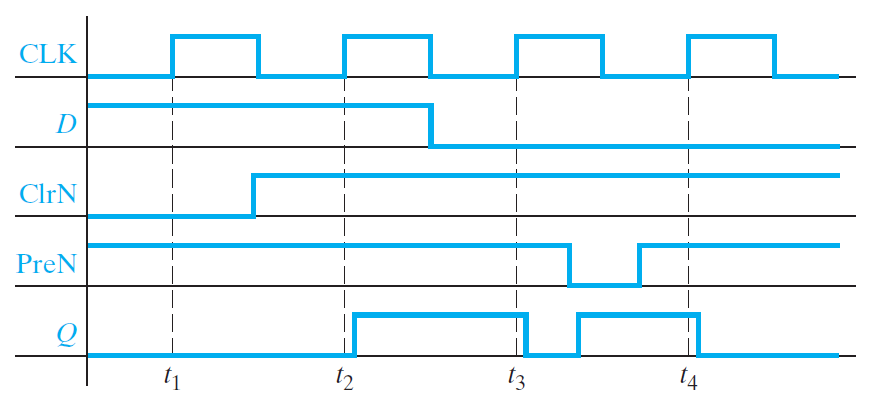
D flip-flop with clock enable¶
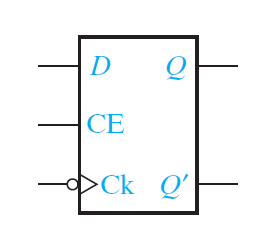
Q+ = Q·CE' + D·CE (when Ck=1)
implementation
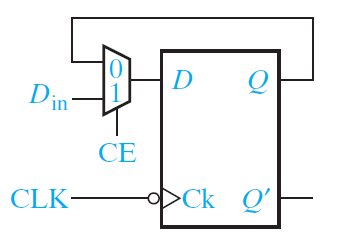
Q+ = Q·CE' + Din·CE
skip 11.9 =))¶
Ch14 Derivation of State Graphs and Tables¶
example:
design the circuit so that any input sequence ending in 101 will produce an output Z = 1
coincident with the last 1
 the symbol before the slash is the input and the symbol after the slash is the corresponding output
the symbol before the slash is the input and the symbol after the slash is the corresponding output
Mealy machine¶
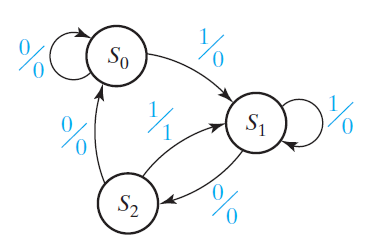
target: \(S_0S_1S_2\) = 101 \(S_0\): get 1 →store it ; get 0 → again
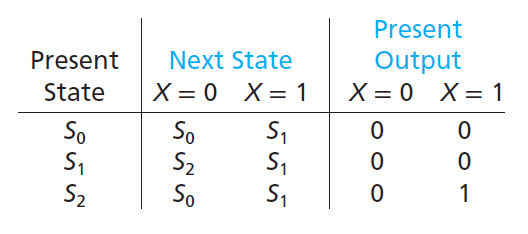
\(S_0S_1S_2\) 基本上可以隨便代
(i.e. \(S_0\) 可以 00 or 01 or whatever 代替)
出來的電路、SOP 會不一樣,但實質結果是相同的
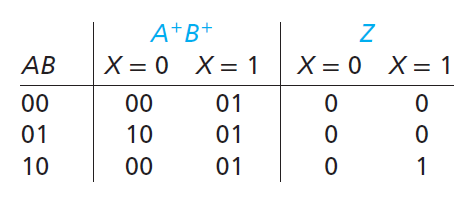
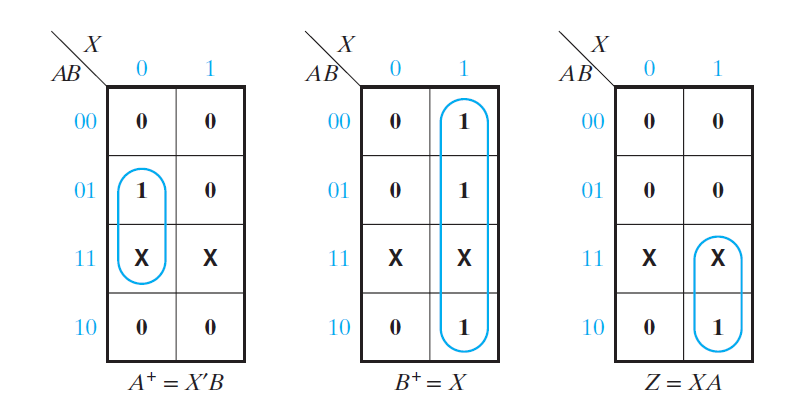
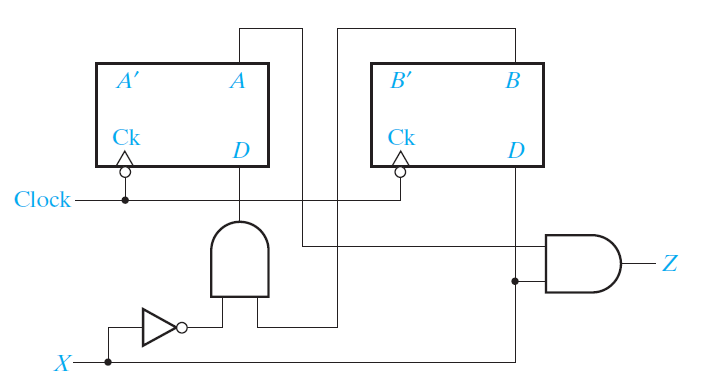
Moore machine¶
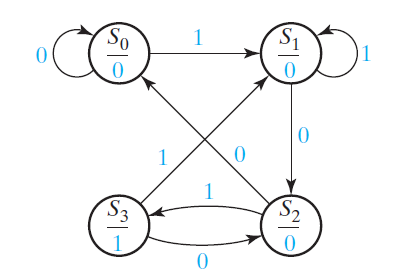
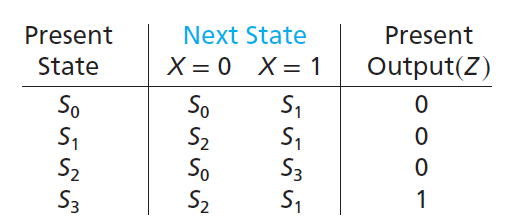
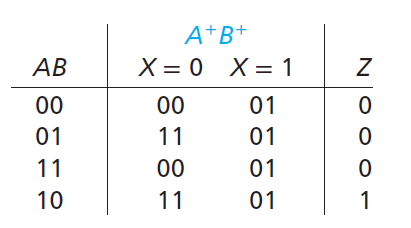
initial state = 1
→ ++01++000 underline part Z=1
14.2 More Complex Design Problems¶
a Mealy example¶
The output Z should be 1 if the input sequence ends in either 010 or 1001, and Z should be 0 otherwise.

010| _10|01
1001| __ 01|0
"|": 接在一起處
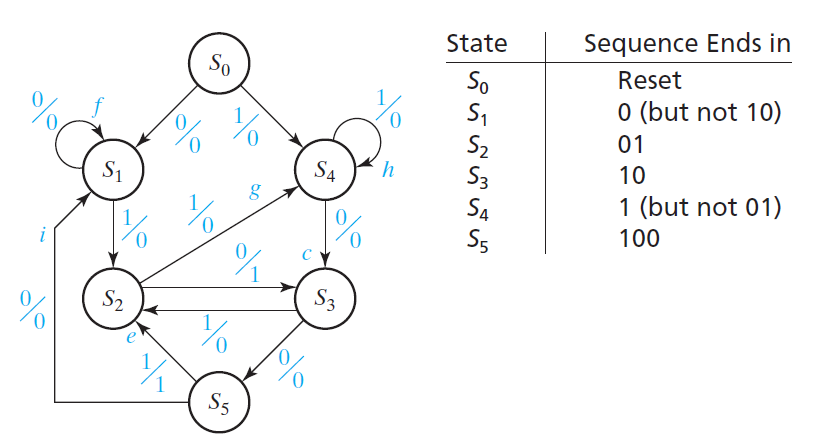
a Moore example¶
The output Z is to be 1 if the total number of 1’s received is ++odd++ and at least ++two consecutive 0s++ have been received.
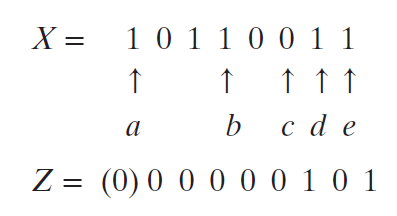

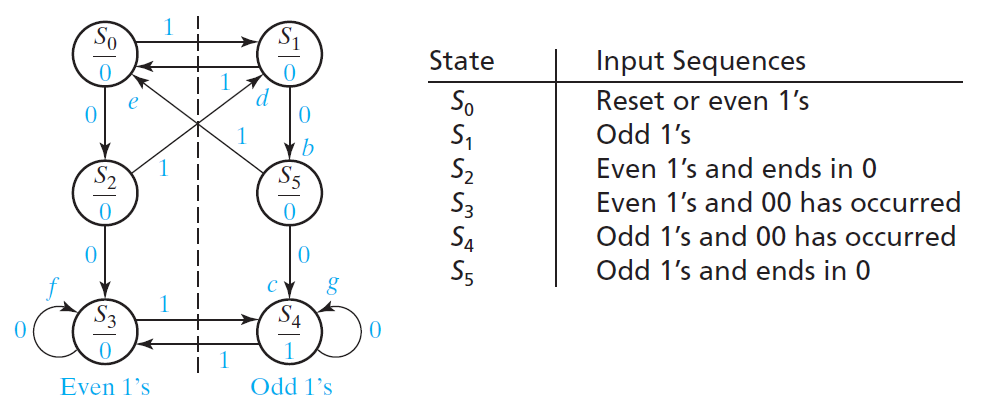
14.3 Guidelines for Construction of State Graphs¶
The circuit examines groups of four consecutive inputs and produces an output Z = 1 if the input sequence 0101 or 1001 occurs. The circuit resets after every four inputs.
【Mealy】

0101 & 1001 可共用
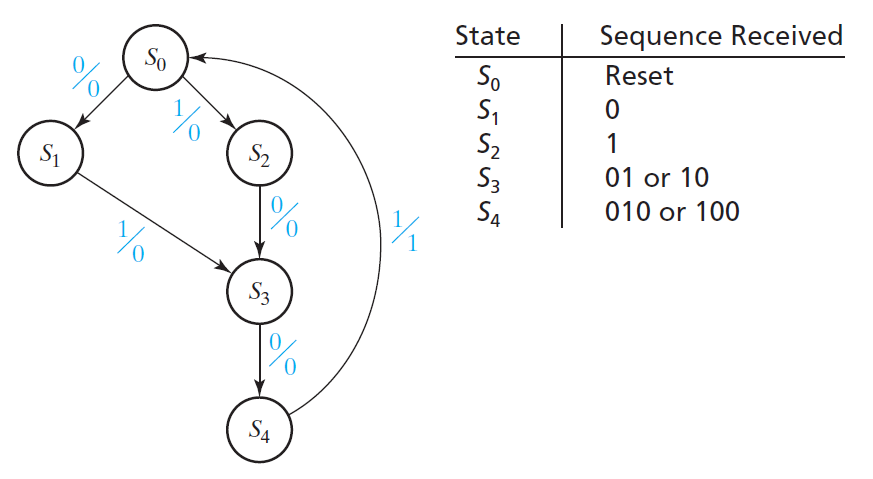
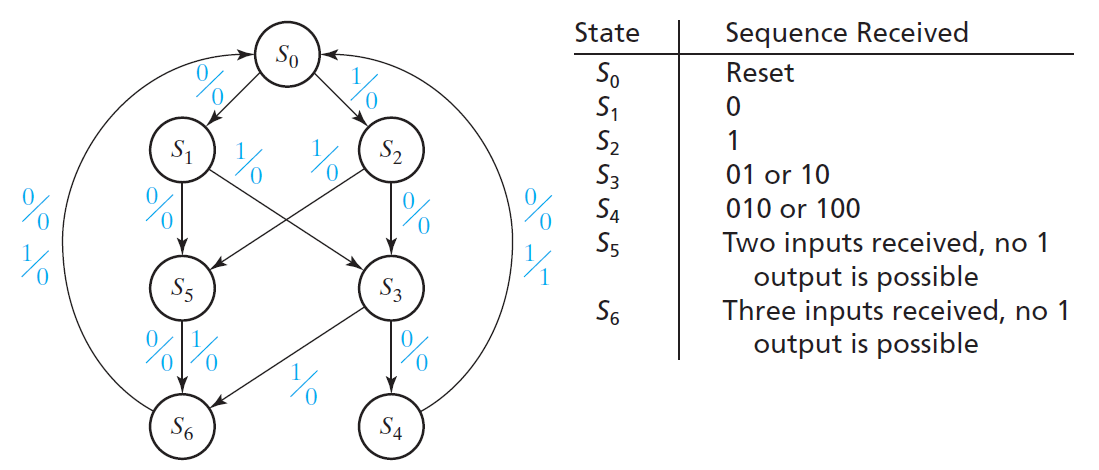
錯的 → 進到紅框區 → output 0
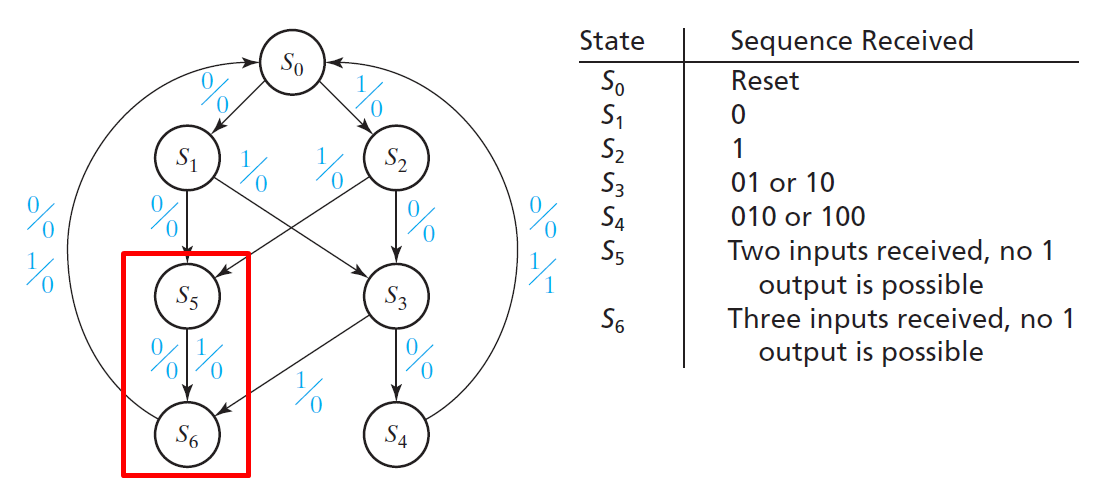
a group of 5 → 下面再多一層 以此類推
==跳過 example 2, 3==
14.4 Serial Data Code Conversion¶
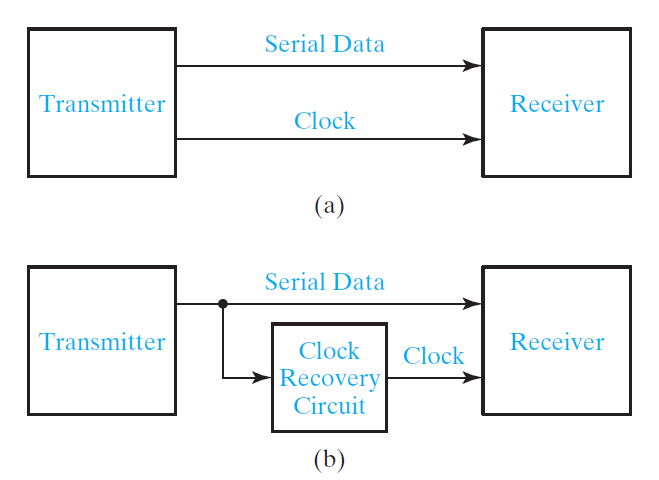
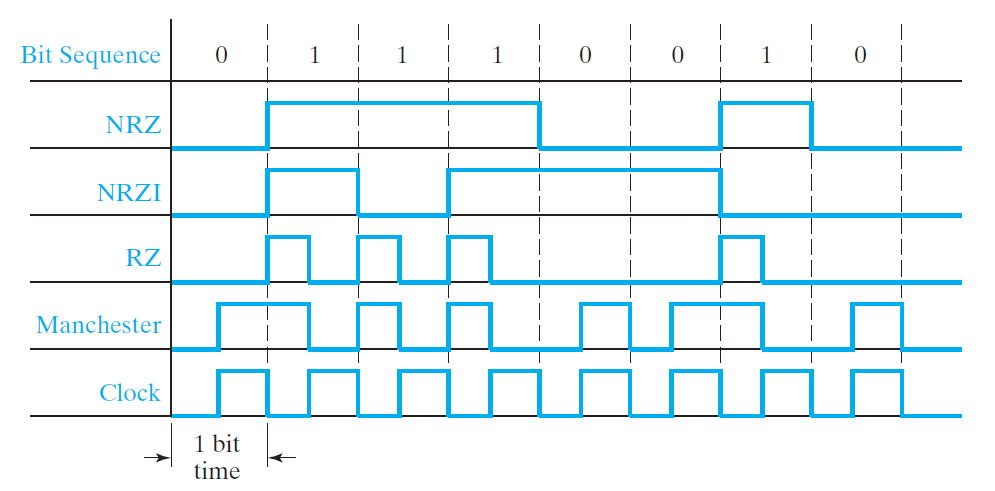
NRZ:non return to zero, 不變
RZ:return to 0, 變 1 後, 後半變回 0
NRZI:inverted, 看 1 的奇偶 (i.e. 0 → \(Q^+=Q\) ; 1 → \(Q^+=Q'\))
Manchester:0 → 後半變 1 ; 1 → 後半變 0
Mealy ver.¶
NRZ {→|convert} Manchester

ideal:忽略延遲
actual:有延遲,出現 false output
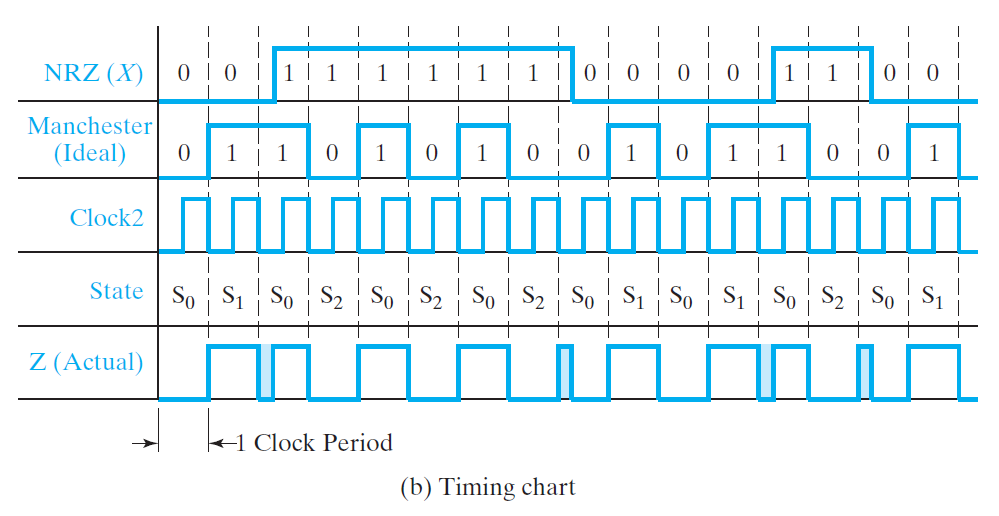
clock2 頻率 2 倍 → 所有 output changes 都在 edge 上
NRZ stable for 2 clock2 period
clock change but input hasn't → glitch
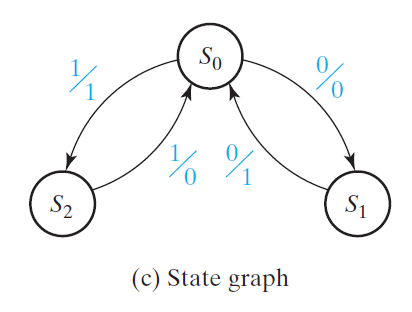
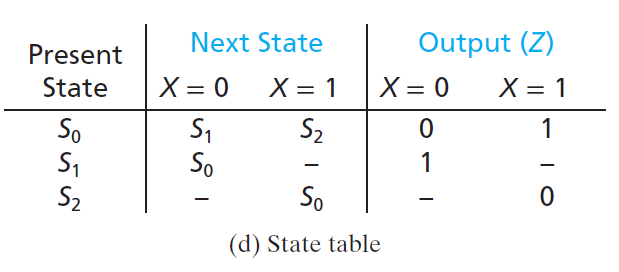
\(S_1\) 完不會有 1 so -
Moore ver.¶
NRZ {→|convert} Manchester
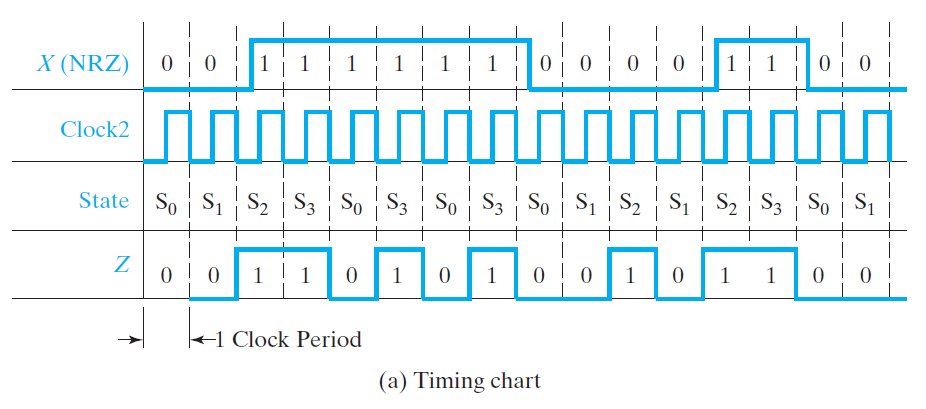
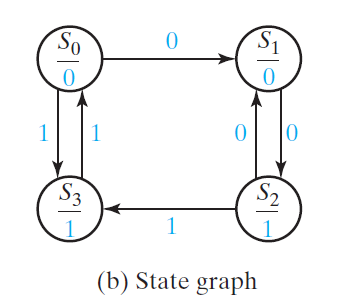
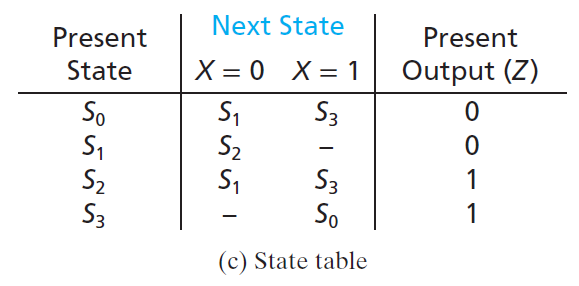
14.5 Alphanumeric State Graph Notation¶
(a) F → forward ; R → reverse
(b) 考量到 FR=11,00
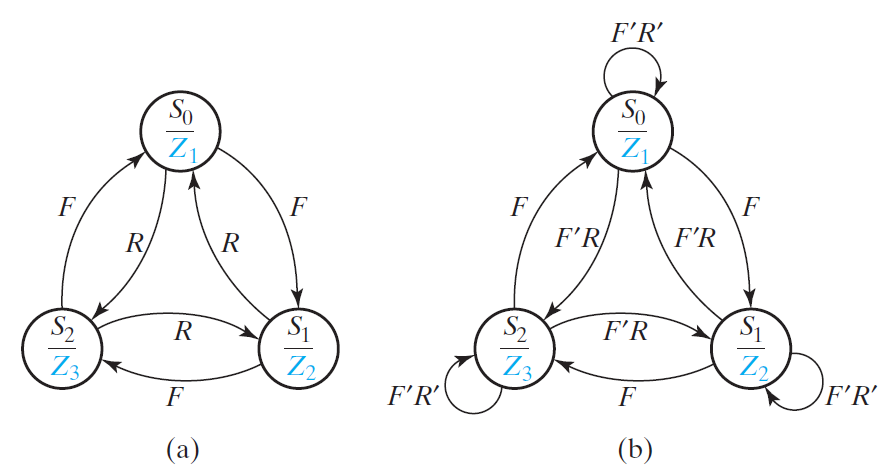
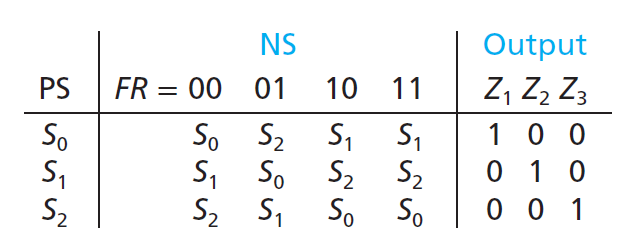
從 \(S_0\) 發出的線
3 條線 or 在一起,為 1 → 至少一條為 1
F + F′R + F′R′ = F + F′ = 1
3 條線兩兩 and 在一起,皆為 0 → 小於 2 條為 1
F·F′R = 0, F·F′R′ = 0, F′R·F′R′ = 0
→ 恰好 1 條為 1
for Mealy:
\(X_iX_j/Z_pZ_q\) means if \(X_iX_j\) = 11 (other Xs don't care), \(Z_pZ_q = 11\) (others Zs = 0)
e.g. \(X_1X_4'/Z_2Z_3\) means 1--0/0110
14.6 Incompletely Specified State Tables¶
BCD (0~9 in binary i.e. 0000-1001)¶
while in last bit:
if 1s = even → 1
else → 0
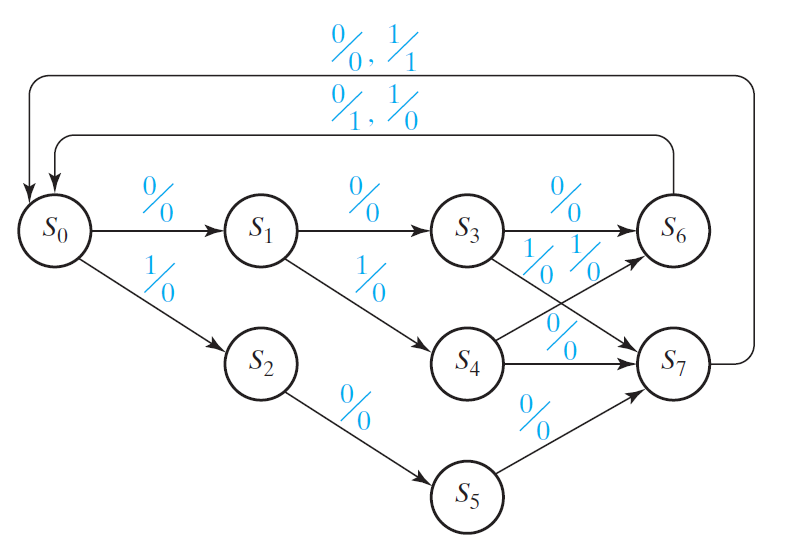
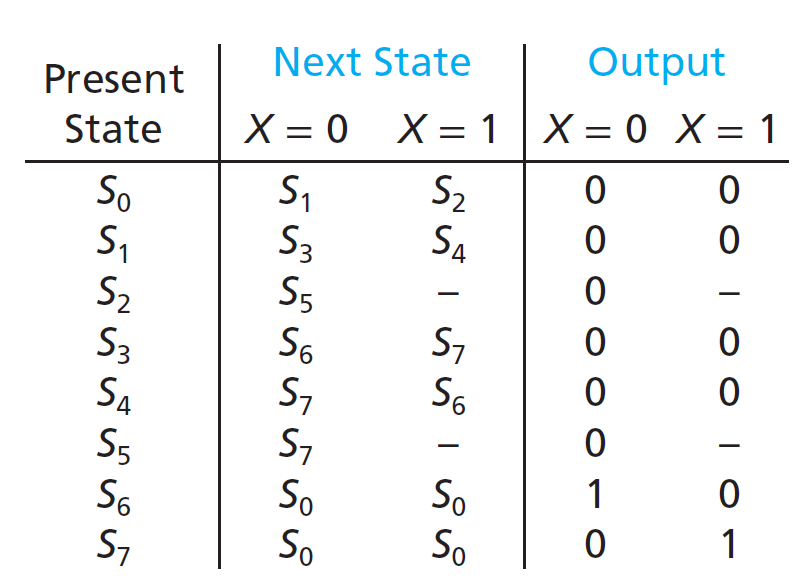
101 disjoint, output only used in the end¶
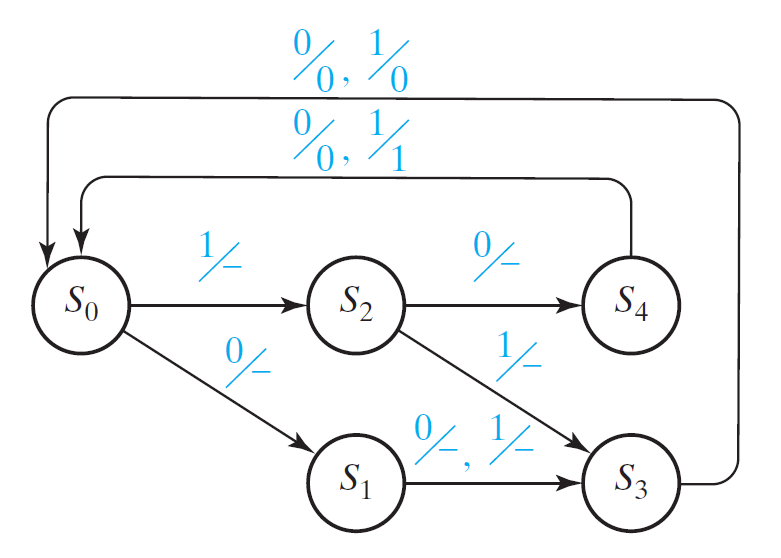
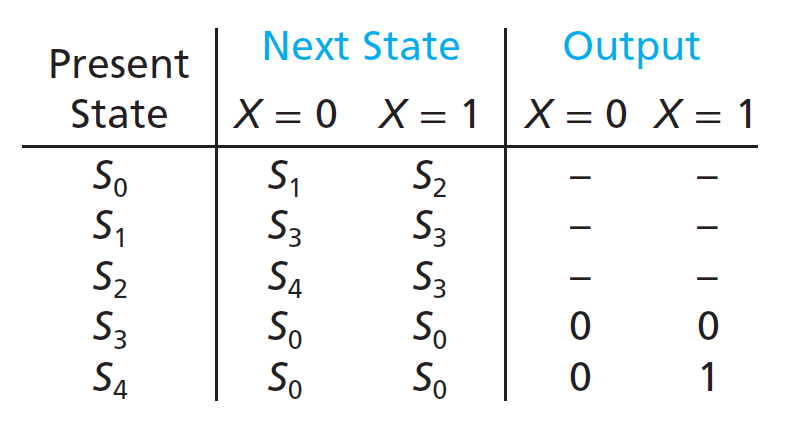
Problems¶
14.16¶


ans
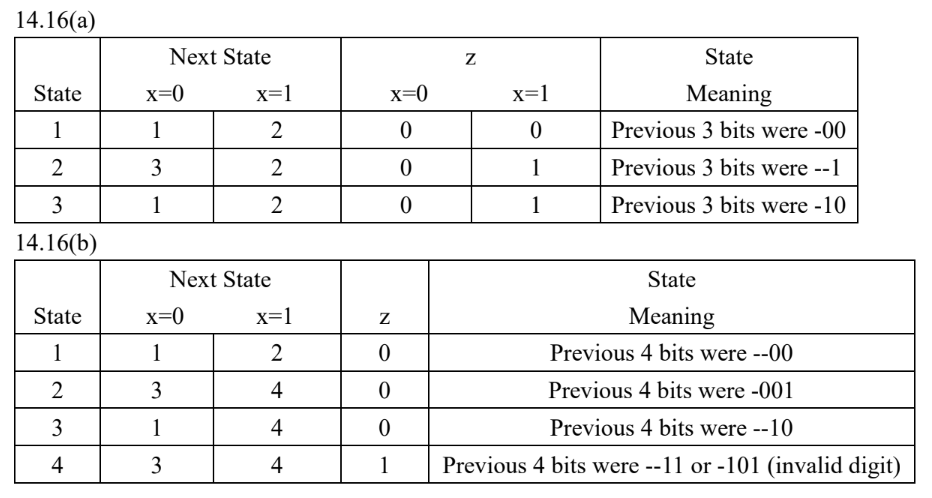
14.31¶


ans
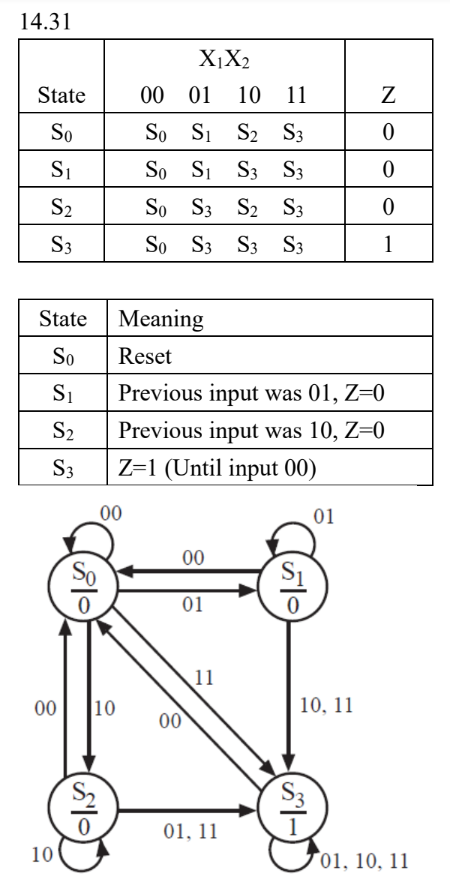
14.33¶
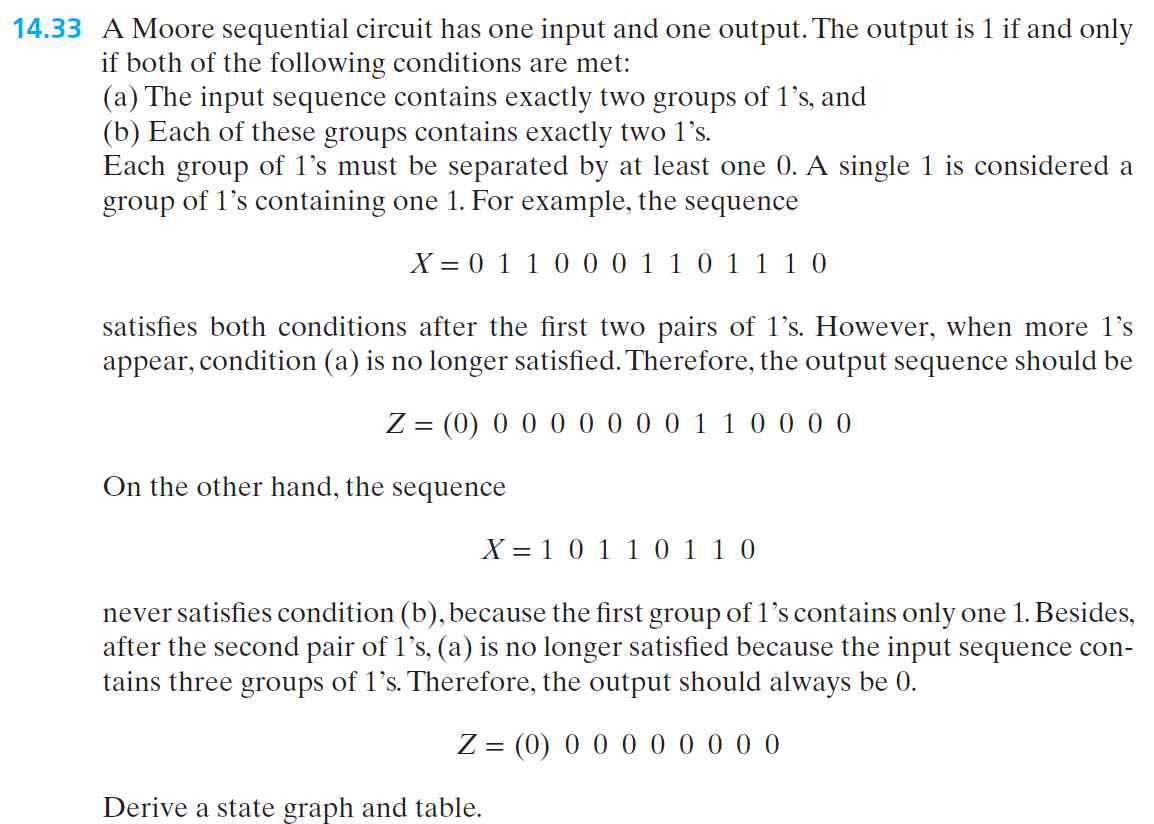 ans
ans
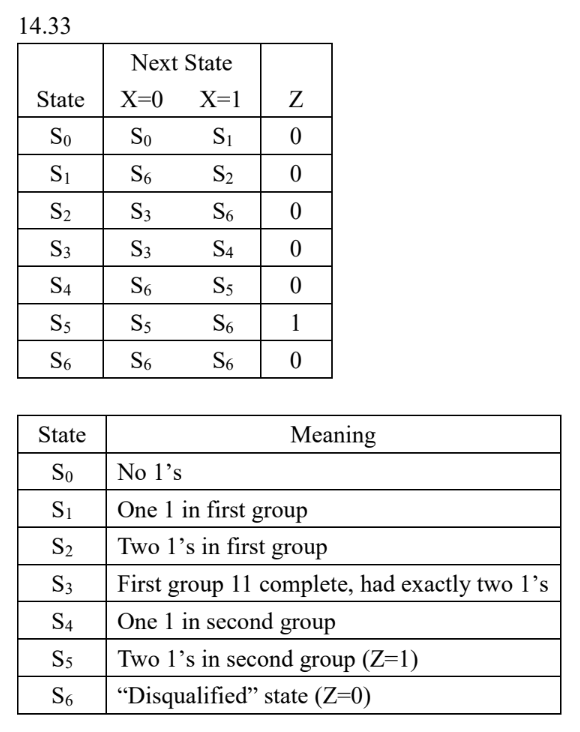
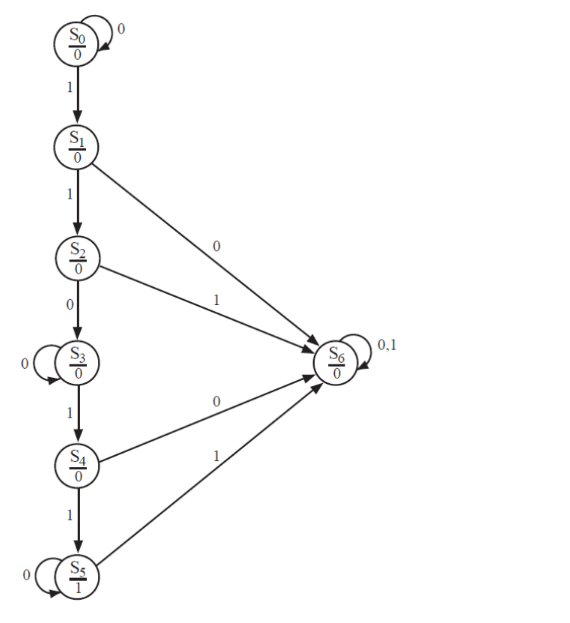
14.38¶
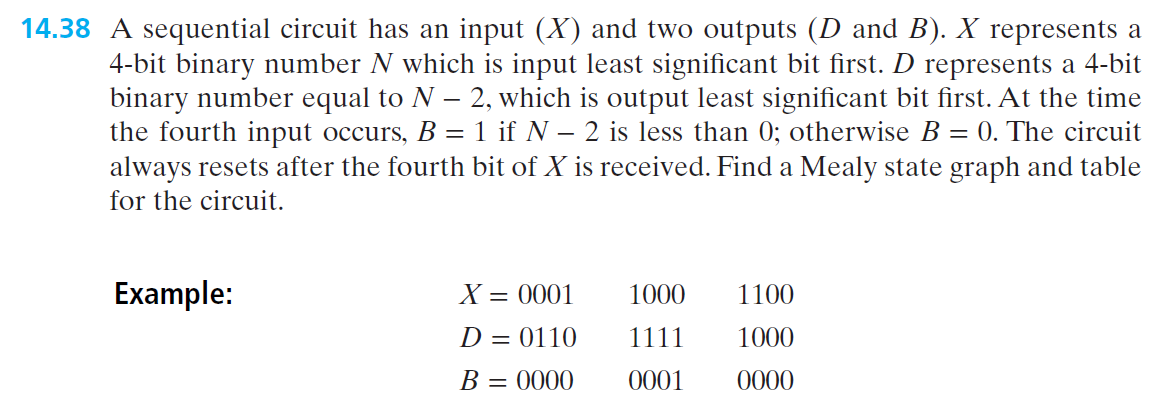 ans
ans
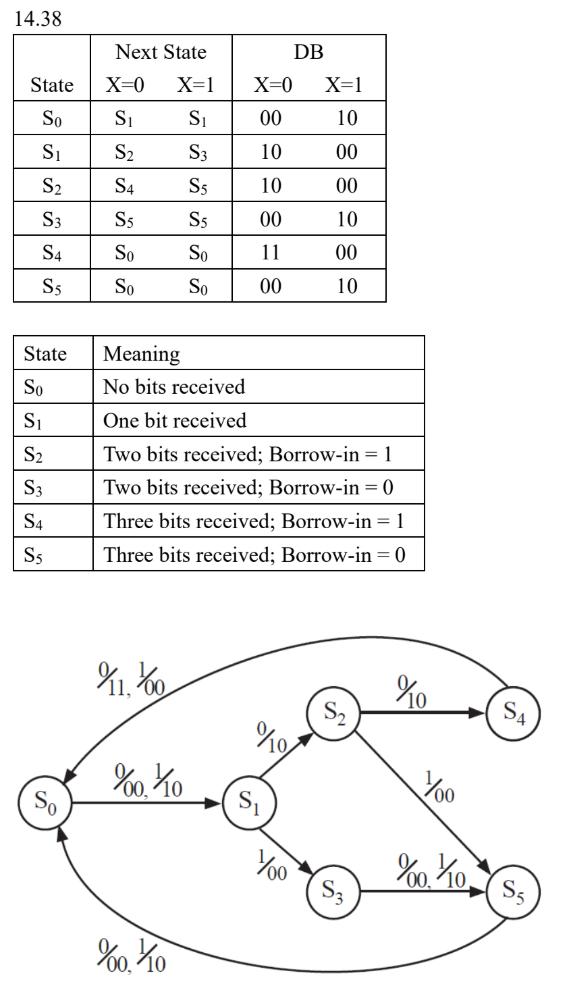
14.43¶
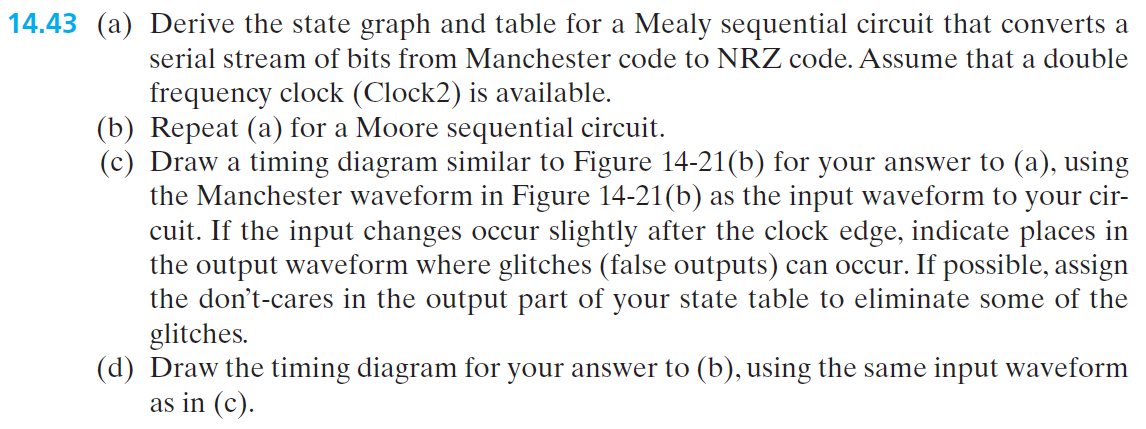 ans
ans
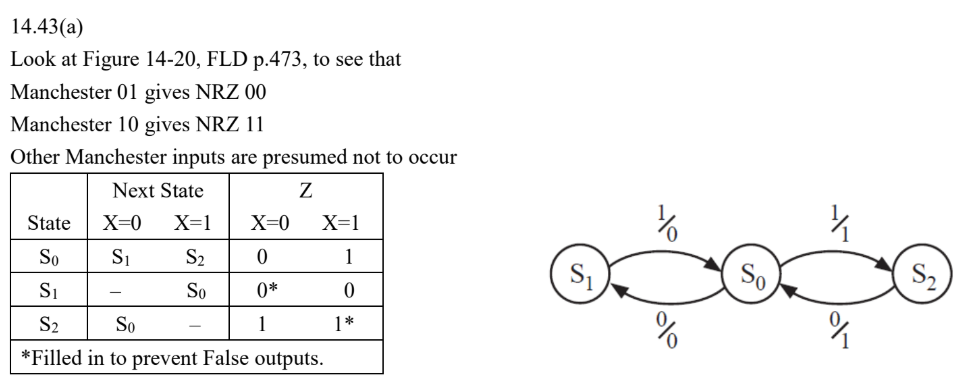

14.45¶
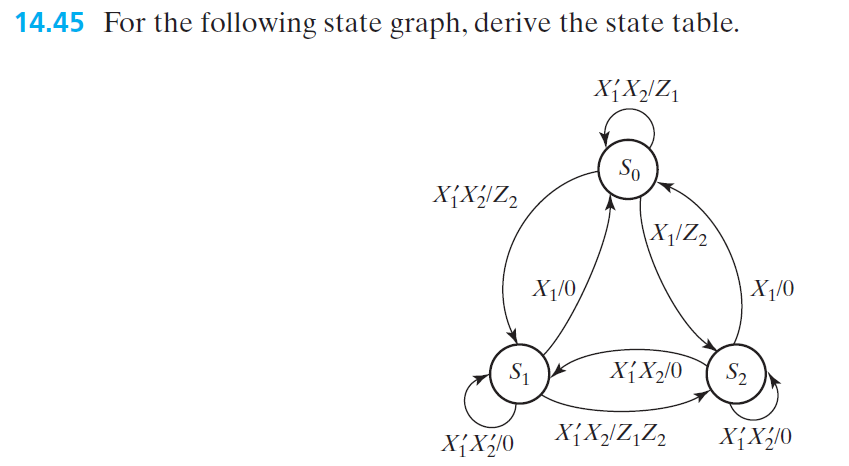 ans
ans
